Please sign in first
Not a member?

- Home
- Online Education Programs
- ISG Journey Thru Gemology
- ISG Credentials
- Legacy Entrance
- Frequently Asked Questions
- Registry of Graduates
- Careers in Gemology
- Important Program Information
- About the ISG
- Why is the ISG Tuition So Low?
- Testimonials of ISG Students and Graduates
- Meet Your Instructor for your ISG education
- ISG Best Online Gemology School
- Graduate Support Programs
- Ishihara Color Vision Test
- Privacy Policy
- Newsletters
- The Story of Ruby
- Turquoise Investigation by the ISG
- The Story of Petrol Quartz
- Top 5 Myths About Jewelry Insurance Appraisals
- The Story of Time
- The Story of Freshwater Pearls
- The Story of Agates and Jaspers
- Susan Bailey v. Frantz Jewelers, et al.
- The Story of Blue Topaz
- The Story of Tibet Andesine
- The Story of Oregon Sunstone
- The Story of Created Moissanite
- Identifying Lab Created Diamonds
- Black Diamond or Created Moissanite?
- Ebay, the GIA, and Section 230
- Lessons From the Angry Janitor
- Exposing the Truth about Lab-Created Diamonds
- AGTA Hobbles Dealers and Buyers
- Appraisers -v- Gem Labs…a Legal Imbalance!
- Understanding the Classification of Diamonds
- Cremation Diamonds: Insuring and Litigating
- Let’s Talk About Gemology Credentials
- Hometown Jewelers and the Force Majeure Clause
- Following the Critical Angle of Diamond Grading
- When Breitling Brought the Airmen Home
- Let’s Open a Refractometer
- Measuring the Energy of Light
- Quick Reference Guide to Sunstone
- ISG Seeing the Invisible Light
- Contact Us
Turquoise Investigation by the ISG
Is this really a group of turquoise bracelets?
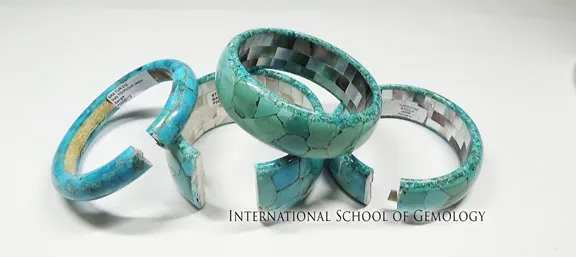
A years-long investigation was conducted at the request of the Navajo Nation.
It is one of those gem materials that, if sold properly, is a wonderful product to have in the showcase. By “sold properly” I mean properly disclosed for what it truly is. Unfortunately, it is being widely sold without proper disclosure in the current market. Even more unfortunate is that the improper disclosure has been made acceptable by none other than the Gemological Institute of America. The product is a material being sold as Natural Turquoise that is actually a manufactured composite product made mostly of glue with a small percentage of turquoise dust for coloring.
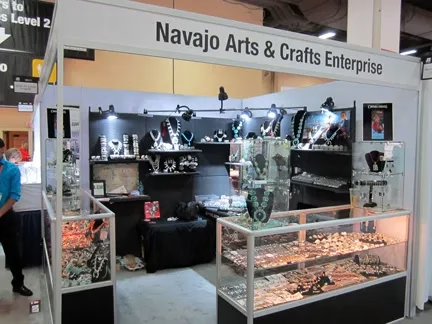
A few years ago, while attending a major trade show in Las Vegas, I was approached by members of the Navajo Nation who were selling their natural turquoise designs at this show. Their issue was that a Chinese dealer just two booths down from them was selling similar looking turquoise beads and bracelets for a fraction of the price as offered by the Navajo Arts and Crafts booth. They wanted to know how this was possible and asked me to investigate. The result of that investigation is below.
The Manufactured Product
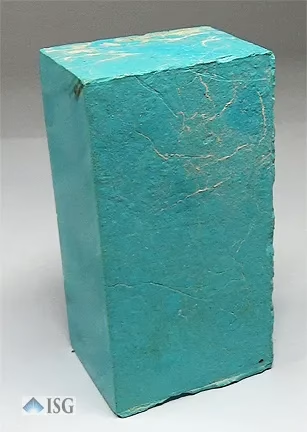
A few months later, at the Tucson Gem Shows, I met a dealer from China who had the largest booth area and collection of turquoise I had seen anywhere. When asked, he was totally open to explain to me his turquoise was a manufactured product composed of turquoise dust and glue. This gentleman had a very large cutting factory in China that cut turquoise for many of the mines around the world. He realized that all of that turquoise dust was going to waste so he swept it all up, put it in a bucket of glue, stirred it up and produced the manufactured turquoise product you see at left. He was totally open about the process and the product, and explained it was composed partly of turquoise dust and mostly glue. I purchased the piece at left to take to the ISG lab and test. The results did not surprise me.
The Study Group
Below is part of the study group I obtained from various dealers and various shows, some of which came the Chinese dealer near the Navajo Nation booth referenced above.
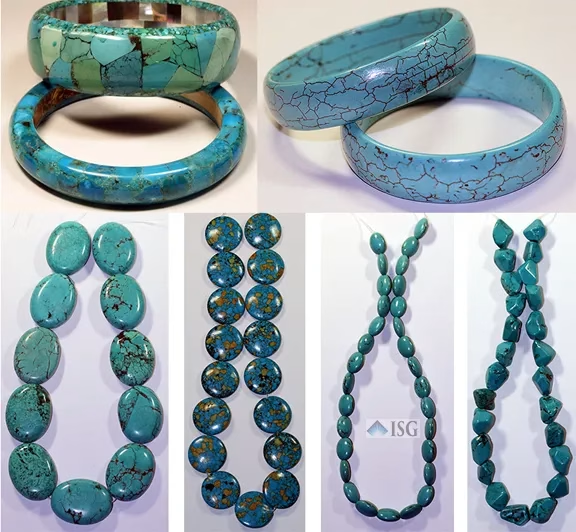
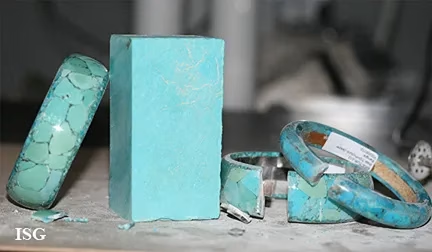
At left you can see where I cut the bracelets to better test the material since they were both coated with some type of clear plastic.
Below are images of the supposed “natural turquoise” after cutting. It cut like plastic. It smelled like plastic while being cut by the Dremel wheel.
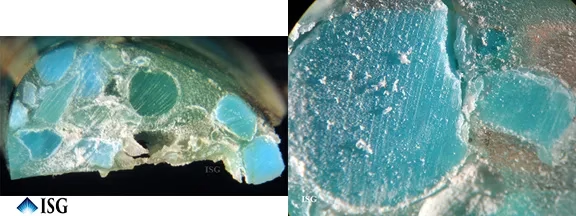
Below are images from a hot point applied to the material. Having heard of my investigation on this topic my dear friend, the late Alan Hodgkinson (RIP) suggested I apply a soldering iron to this material and a natural turquoise I obtained from Sterling Fouts at the Pueblo Show in Tucson. As Alan predicted, the turquoise did not react but the bracelet material burned like…plastic.
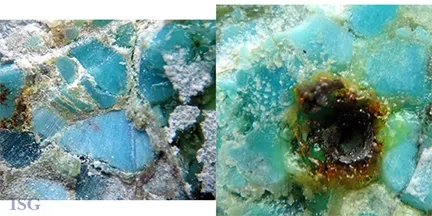
Obviously, this material was a very creative way to profit from the cutting room floor sweeps which, if properly represented, would be a very viable product. The problem was (and is) that this material is being sold as Natural Turquoise because of what, in my professional opinion, is a heinous error by the Gemological Institute of America.
The Federal Trade Commission Guides for the Jewelry Industry
To better understand the situation, it is essential to review the U.S. Federal Trade Commission (FTC) regulations outlined in CFR 16, Section 23.27. This section specifically addresses the deceptive use of the term “natural” when describing manufactured gem materials. According to the FTC guidelines, it is considered deceptive to use the term “natural” to describe a gemstone unless it is wholly derived from nature. Hence, any material that is partially or entirely manufactured, including composites with natural elements, must be accurately disclosed to avoid misleading consumers. From the Legal Information Institute of Cornell Law School website of the FTC Guides:
16 CFR § 23.27 Misuse of the words “real,” “genuine,” “natural,” “precious,” etc.
It is unfair or deceptive to use the word “real,” “genuine,” “natural,” “precious,” “semi-precious,” or similar terms to describe any industry product that is manufactured or produced artificially.
Therefore, the use of the term “natural” to describe a manufactured gem product is “unfair and deceptive”. Which brings us to the heart of the issue.
The GIA Grading Reports
Despite my interviewing the gentleman responsible for the process that produced this material and the test results that clearly demonstrated that this material was plastic and not natural turquoise, reports from the GIA put the quietus on the whole issue. When I filed a formal complaint to the major gem show in Las Vegas, they informed me that the seller, Yee On Gems and Jewellery of Kowloon, Hong Kong, China, produced various GIA Identification Reports verifying their jewelry as Natural Turquoise. One of the bracelets and the GIA report are below.
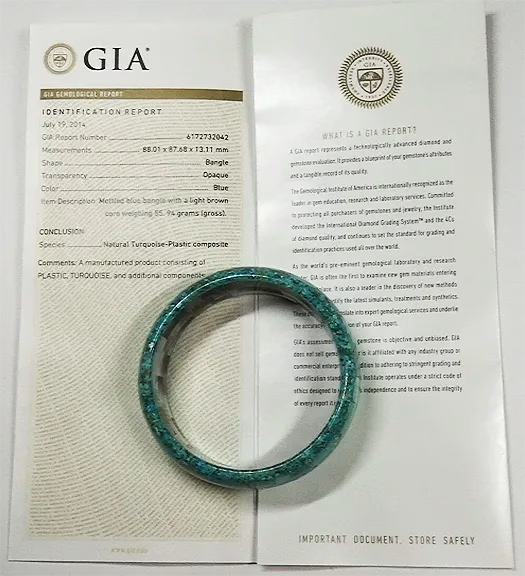
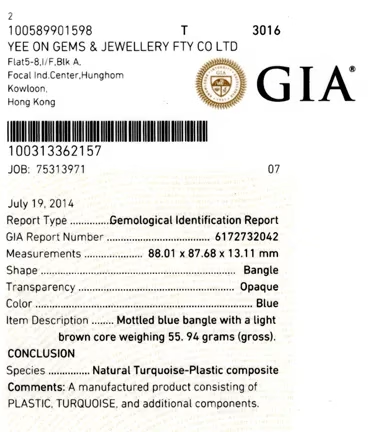
On the left, you will see the mini-report designating the Hong Kong dealer from the major gem show in Las Vegas.
Below, you will see a closeup of one of the report cards. The GIA has identified this as “Natural Turquoise” on one line and “manufactured product” on the next. The problem is the dealer (among many others) sells these jewelry items to consumers and the industry simply as “Natural Turquoise,” referencing these GIA Identification Reports as verification. The major trade show also refused to take any action because, after all (as they said), the GIA says it is “natural turquoise”!
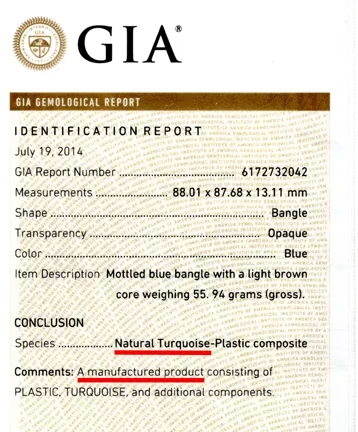
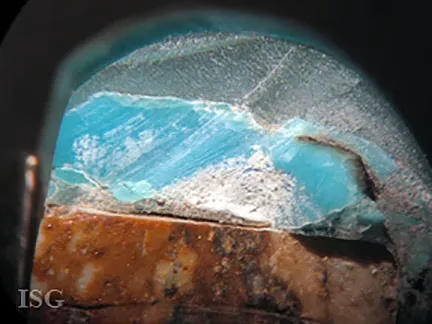 This is all despite the FTC regulations saying it is “unfair or deceptive to use the term…..”natural” to describe any industry product that is “manufactured…”.
This is all despite the FTC regulations saying it is “unfair or deceptive to use the term…..”natural” to describe any industry product that is “manufactured…”.
Based on these GIA reports, every seller I have spoken to since who sells this glue material represents it as “Natural Turquoise” because the GIA identified this manufactured product with the words: “Natural Turquoise.”
Why is there a discrepancy between the GIA and the Federal Trade Commission? That is a question for you and consumers to decide. But the product is available in massive numbers and is being sold right now at the Tucson Gem Shows as “Natural Turquoise.”
I can only imagine the magnitude of damage to the natural turquoise miners and dealers.
I do know the damage that was done to the Navajo Nation turquoise dealers.
When the subject of uniform standards and oversight of this industry is raised, people need to consider situations like the above.
Seriously, think about it.
Rj